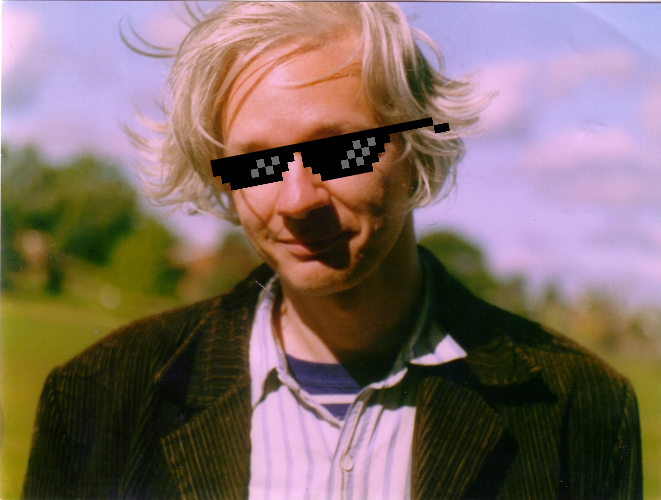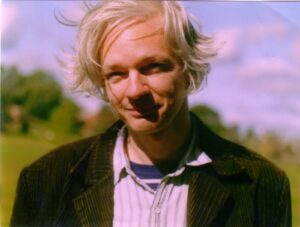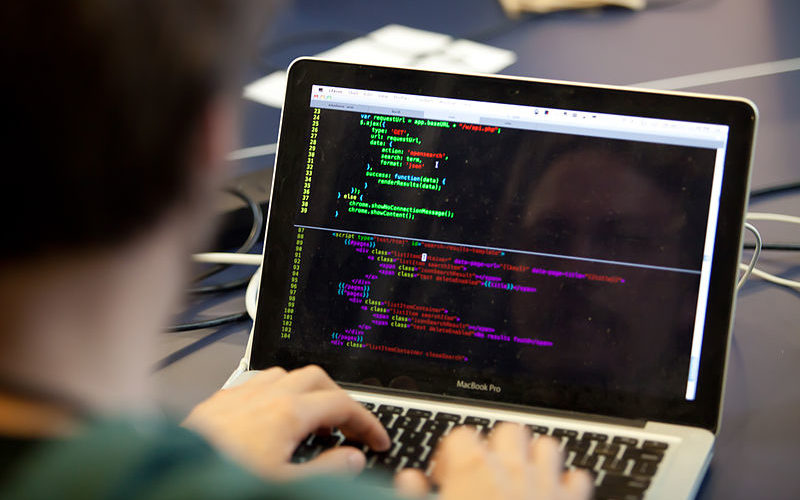Leaked chat logs show that Julian Assange personally intervened with editing Wikipedia articles, sparking a series of coincidences surrounding the Wikipedia articles on WikiLeaks and Julian Assange that escalated to directly recruiting people to edit for him before WikiLeaks ultimately came full circle and copied information from Wikipedia while publishing leaks.
From its launch, WikiLeaks, directly compared itself to Wikipedia. Describing itself as an uncensorable Wikipedia, WikiLeaks said they used an identical interface which anyone could use to upload files, post comments, and discuss leaks. The superficial similarities in the names and branding prompted the Wikimedia Foundation to preemptively register several WikiLeaks-related domain names (which were later transferred to WikiLeaks) as a protective-measure. In 2010, WikiLeaks began distancing itself from Wikipedia, declaring that “WikiLeaks is not like Wikipedia” and changing their About page to say that “unlike Wikipedia, random readers can not edit our source documents.”
Several months earlier, Julian Assange had asked staff and volunteers to be “random readers” who anonymously edited the Wikipedia articles on him and WikiLeaks (something which WikiLeaks said would be unethical). Several months later, WikiLeaks relied on the information provided by Wikipedia’s “random readers” while rushing to publish The Guantánamo Files.
What may have been Assange’s and WikiLeaks’ first overt brush with Wikipedia came on April 9th, 2010 with a tweet from WikiLeaks that said their opponents were responsible for Julian Assange’s Wikipedia page (9 April 2010 revision), and asking readers to “please fix” it because WikiLeaks couldn’t edit it “for ethical reasons.”
Minutes before the tweet was posted, an unregistered Wikipedia editor had finished making a series of edits to Assange’s Wikipedia article. The editor (who appeared to logon from New York City, where Assange traveled that week after premiering the “Collateral Murder” footage in Washington D.C.) largely focused on changing the picture of Assange featured on the page, which was described in edit summaries and on the discussion page as unflattering and unsuitable. The new preferred image had been uploaded on April 1st by Groasvans, an account that claimed to own the image and was dedicated entirely to editing pages related to Julian Assange and Birgitta Jónsdóttir. The story of the photo’s use on Wikipedia, and its alleged history, became more complicated in the coming months.
Two weeks after WikiLeaks’ tweet, Julian Assange went to Wikipedia as himself with notes for the article’s editors, saying that “it would not be ethical for [him] to edit this article directly.” Wikipedia editors praised both Assange’s post and WikiLeaks’ tweet for acknowledging the ethical issues and appearing to follow Wikipedia’s Conflict Of Interest policy. The entirety of his post is quoted below, which notably asks Wikipedia editors to use a version of the previously mentioned photo. Assange later confirmed that he was the one who left the comment, adding that “there are frequent attempts by military apologists and others to manipulate our Wikipedia pages.”
1. I have historically been a private person. However I accept that the public has a certain interest in what I am doing and speaking for and that the article may be valuable to people, if it is done with care.
2. The nature of my work, exposing abuses by powerful organizations and nation states, tends to attract attacks on my person as a way to color debate. The history of this page has numerous examples and, because this page is used as media input by lazy press, the stakes are high. Similarly, even when edits are factually true, there is a spectrum of truths about any person. What is inserted, and its tone, need to be not only true, but fair and representative.
3. The top photo of me is unusual for a public figure and tends to undermine my message. The edit history shows a lot of fights over the photo. The one used is not a press shot and is not suitable to my public role. It is a random photo taken at a random moment during a talk by a random person. Please use a cropped version of http://iq.org/j-big.jpg or another photo that suits my public role.
4. The ‘market desire’ for information about me and my status as a controversial figure has led to people inventing, and reprinting, a lot of junk about me that is either a distortion or is wholly untrue. While the Guardian (with some exceptions) and the New York Times (with few exceptions) have got things right, lesser publications have major errors. Even multiple publications saying the same thing can not be trusted, because they requote each other without attribution. I am attempting to get more into the public record to avoid this tendency, but I would much prefer to spend my time on exposing major abuses by governments and corporations than exposing shoddy journalism about me. Please do that for me, so I can spend time on what I’m good at, instead of reading my Wikipedia page…
Despite Assange’s personal request, the debate over what image to use continued. For editors who opposed the various versions of the requested image, it came down to an issue of copyright. It was unclear who held the copyright, a problem which was made more confusing by versions of the image appearing on the WikiLeaks website, in a Wired article and on Assange’s personal website. On May 16, the image was reuploaded by a user who identified themself as “Martina Haris.” When uploading the file, they made several important claims about the file.
First, Martina Haris claimed authorship for the photograph, like Groasvans had earlier. Second, they said that the image was Creative Commons licensed and had been taken in Australia on Assange’s instructions. Third, Martina Haris dated the photograph to January 4, 2007. As one editor pointed out, this was impossible: the image had been online since at least July 2006, six months before Martina Haris claimed to have taken the photograph. Nevertheless, Assange personally verified Martina Haris’ claim of authorship and copyright by uploading a note to his website.
The issue of the photograph largely died there, with a pair of Australian IP addresses insisting that there was no issue, “end of story” and another user who claimed to have seen a hard copy of the image (which is scanned, not digital) dating it to 2005-2006. However, with Assange himself stating that the image was in the public domain objections to its use dropped. It remains in his Wikipedia article as of this writing. A month later, Assange began directly asking Wikileaks staff and volunteers to edit their Wikipedia pages.
In a chat exchange on June 26th with Sigurdur Thordarson, better known as Siggi, Assange asked him to make sure the WikiLeaks entry of the Icelandic Wikipedia ‘rocked.’ Two days later, the Siggi assured Assange that it was in progress and would be up in a few days.

A few days later on July 2nd, the page was edited by an unregistered user, increasing its size by roughly 3,000%. Almost immediately, Siggi began notifying other Icelandic members of WikiLeaks that it had been done, and telling Assange early the next day that he had “made it rock.”

On July 21st, Siggi received a message from a WikiLeaks volunteer who used the handle “Tastemyhouse.” They apologized for having “shirked” their duty and said that Siggi seemed to have gotten “someone else to clean up the Wikipedia pages, someone who did a good job of it.” Tastemyhouse had previously edited the Assange page at least once while logged into their Wikipedia account. (Cross-referencing information about the editor and additional information from AssangeLeaks about the WikiLeaks volunteer confirms that they’re identical.)

In another chat a month later, Assange told Siggi that it was important to “improve our/my wikipedia page” because of its readership, this time without specifying the Icelandic version of Wikipedia. Hours later, Siggi was asking a new volunteer who used the pseudonym ‘Sarah Wiseman’ to work on the Wikipedia pages. ‘Sarah’ readily agreed, and in the days immediately after the exchange several single-purpose accounts (1, 2) were created to make a handful of edits to Assange’s page.

In mid-September, Assange went to Wikipedia directly and posted a nearly identical comment to his previous one, using the same IP address. In November, a comment from a similar IP address that purported to be from Assange wrote that his first amendment protections were being removed, and that he should be described as a publisher, writer and activist.
By that December, WikiLeaks changed its About page to say that “unlike Wikipedia, random readers can not edit” WikiLeaks’ source documents. On April 25 the following year, Sarah Harrison contacted Siggi about an urgent task. She explained to Siggi that one of the publications for The Guantánamo Files was happening early, and WikiLeaks had to rush to get everything ready. Sarah told Siggi to begin copying names and prisoner numbers from Wikipedia’s List of Guantanamo Bay detainees (April 2011 version) and individual prisoner pages, and that other people were working on it as well. Sarah told Siggi coordinate with a volunteer called Maurice and working with Stella Morris (now Stella Assange), who had recently met Assange and begun working with WikiLeaks as a legal consultant.

Almost immediately afterwards, Maurice began providing more detailed instructions on how to perform the task. The effort must have been well spent, as the next day,Maurice told Siggi that he’d done a good job.

What makes the reliance on copying information directly from Wikipedia especially notable is not simply WikiLeaks’ distancing itself from Wikipedia and its editors, but Assange’s estimation and description of his own organization. Assange was perhaps most explicit several years later, when he rated WikiLeaks as “perfect” while saying that only 2% of mainstream news outlets were even “credible.” He added that it was “an interesting question whether intelligence agencies exceed our capacities — I think probably not.”
As late as January 2016 members of the “WikiLeaks + 10” chat monitored edits to pages related to WikiLeaks (1, 2). In response to the creation of the Wikipedia page for Sigurdur Thordarson, one member off the group wondered “if it’d be better to try and fix the Wiki page or to request for deletion since it’s so bad.”
It’s likely that for some, none of this will matter much. For many others, it will confirm what they have long suspected: that WikiLeaks actively and covertly participated in the editing fights surrounding its pages. For some, WikiLeaks copying information directly from Wikipedia may seem like a necessary and acceptable decision, while others will likely see it as hypocritical or a sign of poor practices.
Ultimately, however, Assange’s and WikiLeaks’ interactions with Wikipedia are more than simply a piece of history. They’re the history of the people who write our history texts and of how those histories are kept.
(Attempts to contact representatives of Stella Assange, WikiLeaks and the Free Assange campaign for comment were not answered prior to publication. )





